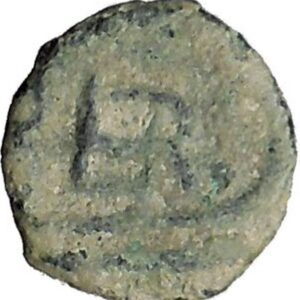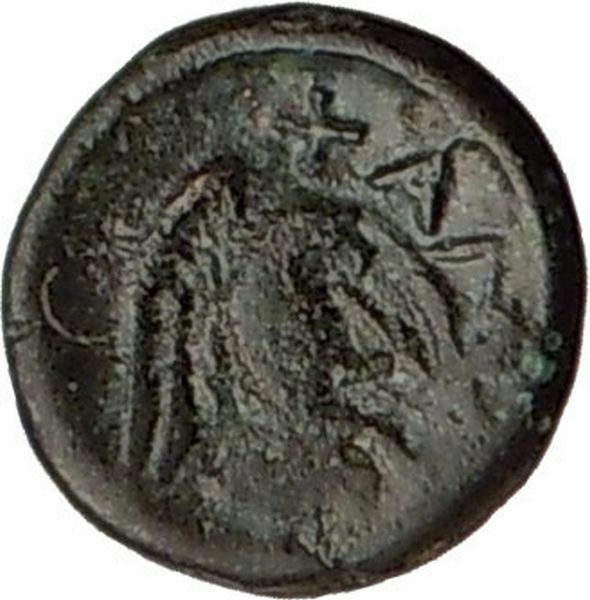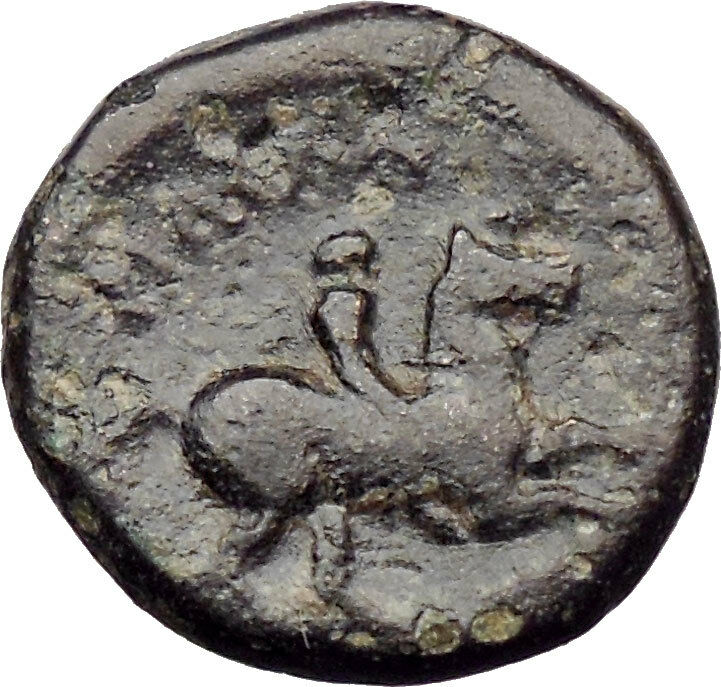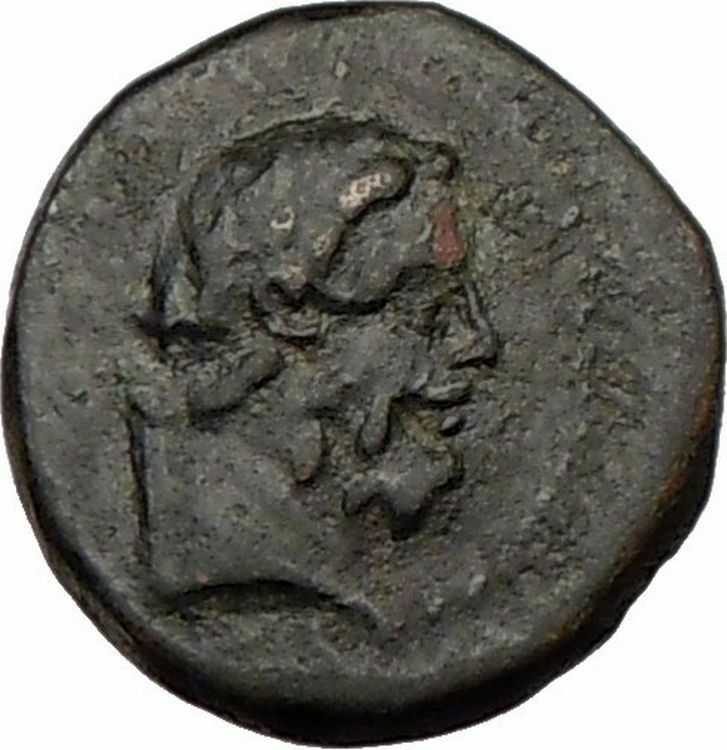|
Greek city of Germe in Mysia Pseudo-Autonomous Issue
Bronze 15mm (2.52 grams) Struck circa 100-130 A.D.
Reference: SNG France 943-50; RPC III 1771
IЄPA CYNKΛHTOC, bare-headed, draped bust of the Roman Senate right.
ΓЄΡΜΗΝΩN, Laureate and draped bust of Apollo right.
You are bidding on the exact item pictured, provided with a Certificate of Authenticity and Lifetime Guarantee of Authenticity.
Roman Senate
One of the most personifications represented emissions autonomous provincial Roman is that of the Roman Senate , widely present emissions of Lydia and Phrygia , in general, much of Asia Minor (Table 9a- c ) .
The reason may be found in the fact that the province of Asia was under the control of the Senate, but this conclusion clashes with the evidence that the Senate has never shown instead in the emissions of other provinces Senators, such as Bithynia .
Emissions autonomous province with the Senate of Rome covering virtually the whole of the period from Tiberius to Philip I, with a maximum in the period of the Antonines and the Severi .
Coinage in the iconography of imperial Rome , the Senate appears robed , with a beard as a sign of maturity , the scepter as a sign of power and sometimes with an olive branch . It is often portrayed in the presence of the imperial figure , ie the emperor shaking hands as a sign of harmony or only hope for such a harmony between the parties, as it appears on a sestertius of Commodus RIC III 549 , a similar scene is found on a sestertius of Hadrian RIC II 968, but here also appears the figure of Rome holding her hands on those imperial and Senate that huddle . On a golden age of Trajan takes on a quasi-religious while sacrificing on an altar in front of the Genius of the Roman People (RIC 374). E ‘ instead of a lone Caracalla Antoninianus RIC 246 and a golden Commodus RIC 157a . The inscription Genivs SENATVS confirms that the embodiment in question is precisely that of the Roman Senate .
In contrast to what was seen for the imperial emissions , the Senate of Rome autonomous provincial emissions is depicted with a portrait male youth with medium length hair type Genio Populi Romani or Bonus Eventus , sometimes the picture is instead purely feminine and l ‘ hairstyle becomes similar to that of Plotina , wife of Trajan, or that of Longina Domitia , wife of Domitian as it appears on the issues of mint Apollonis in Lydia (fig. 14).
The legends that accompany the portrait in emissions are almost independent of the provincial type CYNKΛHTOC, ΣYNKΛHTOC, IERA CYNKΛHTOC, ΘEON CYNKΛHTON, ΣYNKΛHTON or ΘEON CYNKΛHTOY and leave no doubt on the identification. The appeal is therefore the authority of Rome through his organ very representative, who takes on a sacred (IEPA) or divine (ΘEON). As mentioned above, the period Flavio brand the passage from the use of ΘEOΣ to IEPA.
A large bronze issued to Mallus in Cilicia (BMC 30, Levante 1286) portrays the personification with head veiled in conjunction enrollment SACRED SINATVS (fig. 15). In this case, even though the Senate is in the masculine gender, the personification is typically feminine boulh in greek is in fact female and perhaps the engraver of this type did not know Latin well (considering also the obvious corruption of SENATVS in SINATVS) and has remade the genre greek. A similar issue shows instead the legend SACER SENATVS (Ovens n. 537).
How to interpret the presence of this representation emission greek imperial is not easy. It is probably limited to believe that confirmation of the subjection of the Greek cities in Rome were confirmed by the presence of a call to the Senate, since over time the importance of the same was gradually decreasing, while his cult in the provinces remained almost unchanged. It should not be forgotten that the Roman Senate assumes emissions pseudo autonomous on a religious or divine, or IEPA ΘEON (the Senate is the only cult that was called both divine and sacred), and this probably has nothing to do with the control politician of the provinces. “The deification and the consecration of the Roman Senate are a product of the school of thought of the Eastern world, who wants to be surrounded by a halo and be the object of worship every manifestation of human power, as this is considered emanation of divine power” (Forni, 1954).
 In Greek and Roman mythology, Apollo, is one of the most important and diverse of the Olympian deities. The ideal of the kouros (a beardless youth), Apollo has been variously recognized as a god of light and the sun; truth and prophecy; archery; medicine and healing; music, poetry, and the arts; and more. Apollo is the son of Zeus and Leto, and has a twin sister, the chaste huntress Artemis. Apollo is known in Greek-influenced Etruscan mythology as Apulu. Apollo was worshiped in both ancient Greek and Roman religion, as well as in the modern Greco-Roman Neopaganism. In Greek and Roman mythology, Apollo, is one of the most important and diverse of the Olympian deities. The ideal of the kouros (a beardless youth), Apollo has been variously recognized as a god of light and the sun; truth and prophecy; archery; medicine and healing; music, poetry, and the arts; and more. Apollo is the son of Zeus and Leto, and has a twin sister, the chaste huntress Artemis. Apollo is known in Greek-influenced Etruscan mythology as Apulu. Apollo was worshiped in both ancient Greek and Roman religion, as well as in the modern Greco-Roman Neopaganism.
As the patron of Delphi (Pythian Apollo), Apollo was an oracular god – the prophetic deity of the Delphic Oracle. Medicine and healing were associated with Apollo, whether through the god himself or mediated through his son Asclepius, yet Apollo was also seen as a god who could bring ill-health and deadly plague as well as one who had the ability to cure. Amongst the god’s custodial charges, Apollo became associated with dominion over colonists, and as the patron defender of herds and flocks. As the leader of the Muses (Apollon Musagetes) and director of their choir, Apollo functioned as the patron god of music and poetry. Hermes created the lyre for him, and the instrument became a common attribute of Apollo. Hymns sung to Apollo were called paeans.
In Hellenistic times, especially during the third century BCE, as Apollo Helios he became identified among Greeks with Helios, god of the sun, and his sister Artemis similarly equated with Selene, goddess of the moon. In Latin texts, on the other hand, Joseph Fontenrose declared himself unable to find any conflation of Apollo with Sol among the Augustan poets of the first century, not even in the conjurations of Aeneas and Latinus in Aeneid XII (161-215). Apollo and Helios/Sol remained separate beings in literary and mythological texts until the third century CE.
Mysia (Greek: Μυσία, Latin: Mysia) was a region in the northwest of ancient Asia Minor or Anatolia (part of modern Turkey). It was located on the south coast of the Sea of Marmara. It was bounded by Bithynia on the east, Phrygia on the southeast, Lydia on the south, Aeolis on the southwest, Troad on the west and by the Propontis on the north. In ancient times it was inhabited by the Mysians, Phrygians, Aeolian Greeks, and other groups.

Geography
The precise limits of Mysia are difficult to assign. The Phrygian frontier was fluctuating, while in the northwest the Troad was only sometimes included in Mysia. The northern portion was known as Lesser Phrygia or Phrygia Minor (Ancient Greek: μικρὰ Φρυγία), while the southern was called Major or Pergamene. Mysia was in later times also known as Phrygia Hellespontica (Ἑλλησποντιακὴ Φρυγία, “Hellespontine Phrygia”) or Phrygia Epictetus (ἐπίκτητος Φρυγία, “acquired Phrygia”), so named by the Attalids when they annexed the region to the Kingdom of Pergamon.
Under Augustus, Mysia occupied the whole of the northwest corner of Asia Minor, between the Hellespont and the Propontis to the north, Bithynia and Phrygia to the east, Lydia to the south, and the Aegean Sea to the west.
Land and elevation
The chief physical features of Mysia are the two mountains-Mount Olympus at (7600 ft) in the north and Mount Temnus in the south, which for some distance separates Mysia from Lydia and is afterwards prolonged through Mysia to the neighbourhood of the Gulf of Adramyttium. The major rivers in the northern part of the province are the Macestus and its tributary the Rhyndacus, both of which rise in Phrygia and, after diverging widely through Mysia, unite their waters below the lake of Apolloniatis about 15 miles (24 km) from the Propontis. The Caïcus in the south rises in Temnus, and from thence flows westward to the Aegean Sea, passing within a few miles of Pergamon. In the northern portion of the province are two considerable lakes, Artynia or Apolloniatis (Abulliont Geul) and Aphnitis (Maniyas Geul), which discharge their waters into the Macestus from the east and west respectively.
Cities in Mysia
The most important cities were Pergamon in the valley of the Caïcus, and Cyzicus on the Propontis. The whole sea-coast was studded with Greek towns, several of which were places of considerable importance; thus the northern portion included Parium, Lampsacus and Abydos, and the southern Assos, Adramyttium. Further south, on the Eleatic Gulf, were Elaea, Myrina and Cyme.
History
A minor episode in the Trojan War cycle in Greek mythology has the Greek fleet land at Mysia, mistaking it for Troy. Achilles wounds their king, Telephus, after he slays a Greek; Telephus later pleads with Achilles to heal the wound. This coastal region ruled by Telephus is alternatively named Teuthrania in Greek mythology, as it was previously ruled by a King Teuthras. In the Iliad, Homer represents the Mysians as allies of Troy, with the Mysian forces led by Ennomus (a prophet) and Chromius, sons of Arsinous. Homeric Mysia appears to have been much smaller in extent than historical Mysia, and did not extend north to the Hellespont or the Propontis. Homer does not mention any cities or landmarks in Mysia, and it is not clear exactly where Homeric Mysia was situated, although it was probably located somewhere between the Troad (to the northwest of Mysia) and Lydia/Maeonia (to its south).
There are a number of Mysian inscriptions in a dialect of the Phrygian language, in a variant of the Phrygian alphabet. There are also a small number of references to a Lutescan language indigenous to Mysia in Aeolic Greek sources.
Under the Persian Achaemenid Empire, the northwest corner of Asia Minor, still occupied by Phrygians but mainly by Aeolians, was called Phrygia Minor and by the Greeks Hellespontos.
After Rome’s defeat of Antiochus the Great in the Roman-Syrian War, the area, which had been held by the Diadoch Seleucid Empire, passed to Rome’s ally, the kingdom of Pergamon, and, on the death of King Attalus III in 133 B.C., to Rome itself, which made it part of the province of Asia and, later, a separate proconsular Roman province, called Hellespontus.
According to the Acts of the Apostles, the apostles Paul, Silas and Timothy came to (or passed by) Mysia during Paul’s second missionary journey. The narrative suggests that they were uncertain where to travel during this part of the journey, being ‘forbidden by the Holy Spirit to preach the word in Asia’. Shortly afterwards Paul had a vision of a ‘man of Macedonia’ who invited the apostles to travel westwards to Macedonia.
|





 In Greek and Roman mythology, Apollo, is one of the most important and diverse of the Olympian deities. The ideal of the kouros (a beardless youth), Apollo has been variously recognized as a god of light and the sun; truth and prophecy; archery; medicine and healing; music, poetry, and the arts; and more. Apollo is the son of Zeus and Leto, and has a twin sister, the chaste huntress Artemis. Apollo is known in Greek-influenced Etruscan mythology as Apulu. Apollo was worshiped in both ancient Greek and Roman religion, as well as in the modern Greco-Roman Neopaganism.
In Greek and Roman mythology, Apollo, is one of the most important and diverse of the Olympian deities. The ideal of the kouros (a beardless youth), Apollo has been variously recognized as a god of light and the sun; truth and prophecy; archery; medicine and healing; music, poetry, and the arts; and more. Apollo is the son of Zeus and Leto, and has a twin sister, the chaste huntress Artemis. Apollo is known in Greek-influenced Etruscan mythology as Apulu. Apollo was worshiped in both ancient Greek and Roman religion, as well as in the modern Greco-Roman Neopaganism.





